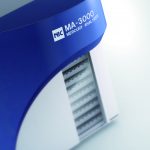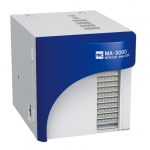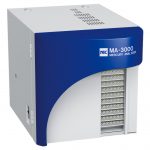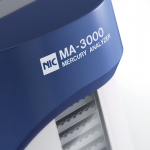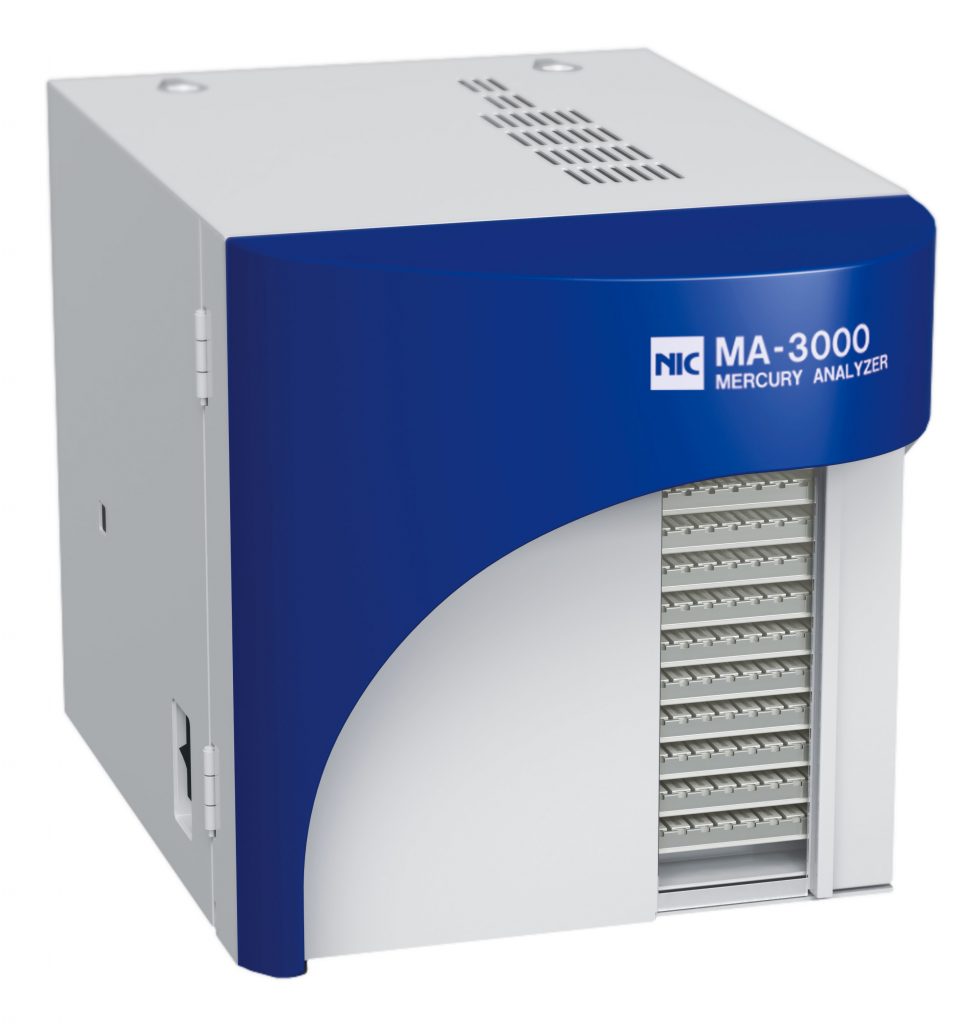
Direct Hg by Thermal Combustion
The NIC MA-3000 Direct Mercury Analyzer determines total mercury in Solid, Liquid and Gaseous matrices using the principle of thermal decomposition, gold amalgamation, and atomic absorption in accordance with USEPA 7473, ASTM D-6722-01. No pretreatment of samples is required when using this instrument for direct mercury analysis.
MA-3000 Direct Mercury Analyzer Key Features:
- Direct Mercury Analyzer with results in as few as 5 Minutes
- Extended Dynamic Range of 0.001ng-2000ng (linear) and cubic fit up to 70,000ng
- Unique Auto Ranging Peak Display with Independent Detectors
- 100 sample position autosampler
- Positive pressure sample container prevents contamination
- Optional Attachments for Reducing Vaporization Method and Gas/Ambient Air Analysis
- Tri-photo sensor optics (Patented – JP No. 5596995) offers simultaneous low and high concentration range measurements, avoids cross over and co-elution of high and low peaks, which is an inherent flaw in other dual-cell detector designs
- Special moisture removal step helps to avoid catalyst overloading and saturation while extending the lifetime of the catalyst tube
- Ceramic sample boats allow for easy acid-washing and drying
- Auto-blanking function on unexpected high-level measurements to avoid carryover to next samples
The MA-3000 direct mercury analyzer offers numerous advantages over other types of mercury analyzer instruments. These include:
- The lowest detection limit and practical quantitation limit (PQL) available in a commercial direct mercury analyzer. With a method detection limit of less than 1pg (0.001 ng), and a practical quantitation limit around 10 to 20 pg (0.01 to 0.02 ng), the NIC MA-3000 is the most sensitive direct mercury analyzer in the market. We achieve this through a high-quality Hg-discharge light source, top-of-the-line transmittance mirrors, and three independent detectors.
- The widest linear range and overall dynamic range in a commercial direct mercury analyzer. With a linear range up to 2,000ng Hg and a Maximum Dynamic Range up to 70,000 ng Hg, achieved through dual-cell, tri-detector optics, the MA-3000 direct mercury analyzer offers a seamless measurement range with precise calibration.
- Numerous value-add, user-friendly features. These features include an easy-to-use visual software interface; a sequence table built similar to Excel; a programmable auto-blanking function to eliminate outlier measurements; diagnostic monitoring and alerts; and maintenance tracking to warn users before analyzer components need to be replaced.
- Cost efficiency and dependability. The MA-3000 is built with premium quality components — including a long-lasting catalyst; a robust gold amalgamator built from proprietary materials; and ceramic sample boats that do not need to be replaced as often as nickel or quartz boats. We also provide replacement catalysts and gold amalgamators with a new installation so that you do not need to invest additional replacement costs for the first 2-3 years of operation.
Recent Publications Using the NIC MA-3000
- Diet shifts drive mercury bioaccumulation and distribution in tissues of the longnose lancetfish (Alepisaurus ferox)
- Contrasting Magnitude and Timing of Pulsed Aqueous Methylmercury Bioaccumulation across a Reservoir Food Web
- Alternate materials for the capture and quantification of gaseous oxidized mercury in the atmosphere
Click Here for additional publications and product information.
Why AGS Scientific?
When purchasing from AGS Scientific, you gain access to our decades of experience in tailoring mercury analyzer solutions; expertise across a broad range of industries in which mercury analysis is required; and signature benefits such as full demonstration and training during equipment installation. Our range of products includes those made by some of the leading manufacturers serving their respective industries. We guarantee your satisfaction, and we will work with you to remedy any issues that may arise today or several years into the future.
To learn more about our capabilities, get in touch with us today and speak with one of our representatives.
Additional Resources (Click Below to Open)


